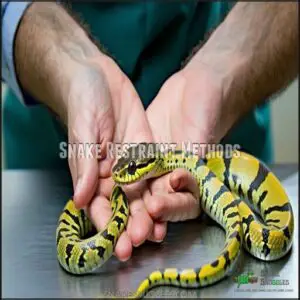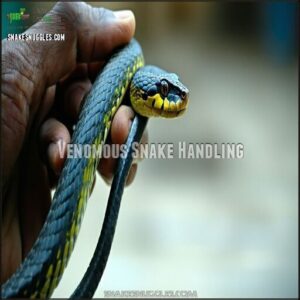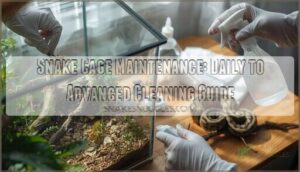This site is supported by our readers. We may earn a commission, at no cost to you, if you purchase through links.
 When you need to securely restrain your pet snake for medication, choose a snake tube or soft towel for safe handling.
When you need to securely restrain your pet snake for medication, choose a snake tube or soft towel for safe handling.
Gently but firmly support the snake’s body, minimizing sudden movements that could trigger defensive reactions.
Wrap the snake loosely, leaving its head exposed for medication administration.
If you’re nervous, ask a trained assistant to help you.
Always approach your snake calmly, speak softly, and move slowly to reduce stress.
Remember, confident and gentle handling is key to successfully medicating your slithery friend without causing unnecessary anxiety.
Want to master snake restraint like a pro?
Table Of Contents
Key Takeaways
- You’ll need to master gentle, slow handling techniques that support your snake’s entire body to minimize stress and prevent defensive reactions during medication.
- Always use the right tools like snake tubes or soft towels, carefully selecting the appropriate size and method based on your snake’s species and temperament.
- You’ll want to watch for stress signals like color changes, erratic movements, and unusual hiding behavior that indicate your snake might be uncomfortable during handling.
- It’s crucial to work with a trained assistant when possible, wearing protective gear and maintaining calm, predictable movements to ensure both your safety and your snake’s well-being during medication.
Snake Restraint Methods
Regarding medicating your pet snake, knowing the right restraint methods can make all the difference between a smooth process and a stressful ordeal.
You’ll want to master gentle, supportive techniques that keep both you and your snake safe during medication administration.
Using Snake Tubes
A variety of snake tubes made from durable polycarbonate can transform your snake handling experience.
Select the right tube size based on your snake’s length for peak restraint.
Insert the snake’s head first, then gently coax half its body inside.
For specialized needs, consider exploring various polycarbonate snake tubes.
Grasp the tube and body firmly to prevent escape, securing a safe and stress-free procedure.
Handling Aggressive Snakes
After mastering snake tubes, you’ll want advanced skills for handling aggressive snakes.
Master snake tubes and advanced handling techniques to safely manage even the most aggressive serpents.
Wear protective gear and maintain safe distancing to prevent strikes. Experienced handlers know slow movements are key.
If the snake seems agitated, consider chemical sedation or seek professional help.
Stay calm, avoid sudden gestures, and prioritize both your safety and the snake’s well-being during snake restraint.
Using a snake hook can also help to safely interact with the snake.
Supporting Snake Body
The art of supporting a snake’s body is critical for preventing injury and ensuring handler safety.
When handling your pet snake, always provide full-body support to distribute its body weight evenly.
Use one hand to secure the head and another to support the body’s midsection, creating a secure hold that keeps both you and your snake comfortable during snake restraint and medication administration.
Remember to approach snakes slowly, as safe snake handling is paramount.
Safe Handling Techniques
With careful steps and a steady hand, you’ll master safe snake handling techniques that protect both you and your scaly companion.
Species identification is your first critical checkpoint before approaching any snake restraint scenario.
Wear disposable gloves and have proper handling equipment ready to minimize risks during reptile interactions.
Your gradual approach matters—move slowly and deliberately, supporting the snake’s entire body to prevent stress or potential defensive strikes.
When administering medication or performing routine checks, always use an assistant to provide additional control and safety.
Hygiene protocols are non-negotiable: wash your hands thoroughly before and after handling to prevent cross-contamination.
Learn to read your snake’s body language, recognizing signs of potential aggression or discomfort. Keep your movements predictable and calm, avoiding sudden jerks that might startle your pet.
Remember to research snake species before handling to make certain.
Remember, confident but gentle handling builds trust and makes for a safer experience for both of you.
Minimizing Snake Stress
When handling your pet snake, you’ll want to understand its stress signals to keep it calm and comfortable during medication.
By recognizing signs of agitation and creating a peaceful environment, you’ll minimize your snake’s anxiety and make the entire process smoother for both of you. Stress signals
Recognizing Signs of Stress
When handling snakes, watch for subtle defensive postures and snake behavior warning signs.
Subtle snake movements speak volumes—listen carefully to your reptilian friend’s unspoken language of caution and care.
Color changes, erratic movements, and breathing changes can signal stress.
Notice if your snake’s appetite drops, hides more often, or moves slowly when handled.
These snake aggression indicators aren’t just quirks—they’re your pet’s way of communicating discomfort or potential health issues.
Observing their behavior when handled can reveal if they’re displaying signs of stress.
Providing Calm Environment
When spotting stress in your snake, creating a tranquil habitat is key.
Reduce noise levels and dim lighting to help your scaly friend feel secure.
Gentle handling in a quiet space prevents anxiety.
Use soft movements and provide a stable surface that offers secure support.
Think of it like creating a serene sanctuary for your pet snake’s comfort.
Avoiding Sudden Movements
When handling snakes, your movements can make or break the interaction. A calm approach is your secret weapon for stress-free snake restraint.
- Keep motions slow and deliberate
- Predict and plan each action
- Maintain gentle, steady handling
- Watch snake body language closely
- Move with snake awareness
Sudden jerks trigger defensive responses, turning a peaceful moment into a potential danger zone.
Inadequate enclosures can also lead to claustrophobia and stress.
Medication Administration
When your pet snake needs medication, you’ll want to approach the task with calm confidence and careful technique.
Mastering safe restraint methods will help you administer treatment smoothly while keeping both you and your snake comfortable and stress-free.
Oral Liquid Medication
After minimizing your snake’s stress, focus on oral liquid medication.
Use a tongue stick or credit card to gently open its mouth.
Administer medication slowly to prevent aspiration, ensuring room-temperature liquid.
Follow with water to clear residue.
Precise dosage calculation is key—typically 10-50 mg/kg depending on the medication—and always monitor your snake’s swallowing technique.
Many owners purchase snake medication online for convenience.
Securing Snake Head
When securing a snake’s head, you’ll want to master the art of grip location.
Gently grasp the snake just behind its head, supporting the neck without applying excessive pressure.
Use a soft yet firm touch to stabilize the head during medication, guaranteeing handler safety and minimizing potential injury.
Your confident control prevents snake stress and secures a smooth process.
Using Assistants
After carefully grasping the snake’s head, you’ll want a reliable assistant to support your medication mission.
Team coordination is key—assign clear roles and communicate expectations.
Experienced snake handling assistants can steady the snake’s body, preventing unexpected movements.
By working together with safety protocols in mind, you’ll guarantee smooth medication administration for your pet snake. Team coordination is key.
Venomous Snake Handling
When dealing with venomous snakes, you’ll need specialized skills and knowledge that go far beyond handling their non-venomous cousins.
Only trained professionals should attempt to handle these potentially deadly creatures, using precise techniques and chemical restraint methods to minimize risk and guarantee both human and snake safety.
Chemical Restraint Methods
After administering oral medication, you’ll want to contemplate chemical restraint for more complex procedures.
Ketamine serves as a go-to dissociative drug for snake sedation, with intramuscular injection being the preferred technique.
Veterinarians often combine sedatives like dexmedetomidine and hydromorphone for effective anesthesia.
Always calculate precise dosages and monitor the snake closely, with atipamezole ready as a potential reversal agent.
Antivenom Availability
Discover the lifeline of snake bite treatment by understanding antivenom access challenges.
Regional shortages can make snake envenomation treatments unpredictable, with prices skyrocketing and availability dwindling.
Critically, snake identification becomes key when searching for appropriate antivenom.
WHO recommends strategic placement and affordable access to these essential medicines, making sure you’re prepared for potential venomous snake encounters.
Experienced Personnel Only
Concerning venomous snakes, only seasoned professionals with Advanced Training should take the reins.
Specialized Knowledge and Handling Certification aren’t just fancy titles—they’re lifelines.
You’ll need emergency protocols, Venomous Expertise, and razor-sharp snake restraint methods to safely navigate these high-stakes interactions.
One wrong move could turn deadly, so expertise isn’t optional—it’s absolutely critical.
Knowing a snake’s defensive postures can help prevent unwanted strikes.
Frequently Asked Questions (FAQs)
Can different snake species require unique restraint?
Each snake species presents unique challenges when restraining.
You’ll need to adapt your technique based on size, temperament, and specific behaviors, ensuring both your safety and the snake’s comfort during handling.
How to prevent snake from becoming aggressive?
Stay calm and move slowly around your snake.
Create a peaceful environment, avoid sudden movements, and use gentle handling techniques.
Minimize stress by maintaining a consistent routine and respecting the snake’s personal space.
What medications are safe for snakes?
Ever wondered what meds keep your slithery friend healthy?
Consult a reptile vet for species-specific treatments.
They’ll prescribe antibiotics, antiparasitics, or pain relievers customized to your snake’s unique health needs, securing safe and effective care.
Do snake size and weight matter?
Restraint techniques vary by snake type.
Larger snakes demand more handlers and support – one person per three feet.
Your weight and strength determine safe handling, so adapt your approach carefully to prevent injury or stress.
How often should snakes receive medication?
Like a compass guiding sailors, your vet’s expertise determines your snake’s medication frequency.
They’ll assess your pet’s health, species, and specific condition to recommend the right treatment schedule customized to its unique needs. They’ll assess.
Conclusion
Ultimately, securely restraining your pet snake for medication doesn’t have to be a slippery challenge.
By mastering gentle handling techniques and understanding your snake’s stress signals, you’ll transform medication time from a potential wrestling match into a calm, controlled experience.
Remember, confidence and patience are your best tools when securely restrain pet snake for medication.
With practice, you’ll become a snake-handling pro, keeping your scaly friend healthy and stress-free.
- https://www.dvm360.com/view/restraint-physical-examination-and-venipuncture-techniques-reptiles-proceedings
- https://todaysveterinarynurse.com/behavior/low-stress-veterinary-visits-for-reptiles/
- https://aestoney.com/blog/snake-restraining-tubes-everything-you-need-to-know/?srsltid=AfmBOop56gxKq7NDg71G03HO2Q3H2JJR-6Mqci4esfBADBJD0uRYaisL
- https://www.sciencedirect.com/science/article/abs/pii/S1557506308001316
- https://www.merckvetmanual.com/exotic-and-laboratory-animals/reptiles/clinical-procedures-for-reptiles












